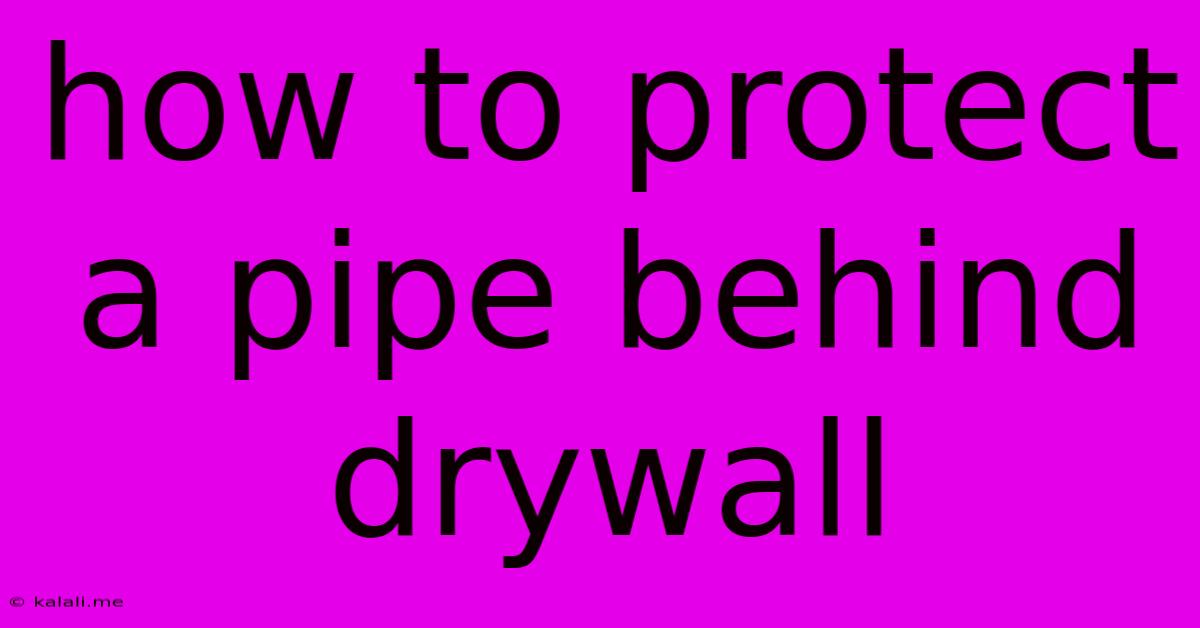How To Protect A Pipe Behind Drywall
Kalali
Jun 10, 2025 · 3 min read

Table of Contents
How to Protect Pipes Behind Drywall: Preventing Leaks and Damage
Protecting pipes hidden behind drywall is crucial for preventing costly water damage and frustrating repairs. This comprehensive guide will walk you through the best practices to ensure your plumbing remains safe and sound, avoiding future headaches. We'll cover everything from initial installation to ongoing maintenance, focusing on proactive measures to safeguard your home's integrity.
Why Protect Pipes Behind Drywall?
The simple answer is prevention. Unprotected pipes are vulnerable to several issues:
- Leaks: Corrosion, age, and shifting foundations can cause pipes to crack or leak, leading to water damage unseen behind your walls. This damage can quickly spread, affecting insulation, structural elements, and even leading to mold growth.
- Freezing: Exposed pipes in uninsulated areas are susceptible to freezing, especially during cold weather. Frozen pipes expand, potentially bursting and causing significant flooding.
- Rodent Damage: Pipes can become targets for rodents seeking warmth and shelter, leading to gnawing and leaks.
- Accidental Damage: During renovations or repairs, accidentally piercing a pipe hidden within the wall can cause significant damage.
Best Practices for Protecting Pipes Behind Drywall:
1. Proper Installation is Key
- Use high-quality materials: Invest in durable, corrosion-resistant pipes. Copper and PEX piping are popular choices known for their longevity.
- Securely fasten pipes: Properly secure pipes to prevent movement and vibration that can weaken connections over time. Use appropriate clips and straps designed for your pipe material.
- Insulate pipes: Insulation protects against freezing and temperature fluctuations. Use foam pipe insulation specifically designed for plumbing applications. Pay particular attention to pipes in exterior walls or unheated spaces.
- Accessible shut-off valves: Install easily accessible shut-off valves near each fixture. This allows you to quickly turn off water supply in case of a leak, minimizing damage.
2. Protecting Pipes During Construction
- Use protective sleeves: Enclose pipes in protective sleeves made from a durable, non-corrosive material. This adds an extra layer of protection against damage during drywall installation.
- Properly route pipes: Avoid placing pipes in areas prone to high traffic or potential damage. Designate specific pathways for plumbing lines to minimize risk.
- Careful drywall installation: Use caution during drywall installation to prevent puncturing pipes. Use a stud finder to locate the pipes and studs before screwing in drywall.
3. Ongoing Maintenance and Monitoring
- Regular inspections: Periodically inspect your plumbing system for leaks or signs of damage. Listen for unusual sounds like dripping or gurgling.
- Monitor water pressure: Sudden changes in water pressure could indicate a problem.
- Address leaks promptly: Never ignore a leak. Repair leaks immediately to prevent further damage.
4. Detecting Leaks Early: Advanced Techniques
- Moisture meters: These handy tools can detect moisture behind drywall, indicating potential leaks.
- Leak detectors: Electronic leak detectors can sense changes in water flow, alerting you to potential problems.
Conclusion:
Protecting pipes behind drywall is a proactive approach to preventing costly repairs and water damage. By following these best practices – from proper installation and material selection to regular inspections and preventative maintenance – you can ensure your plumbing system remains safe, reliable, and trouble-free for years to come. Remember, prevention is always cheaper and less stressful than remediation!
Latest Posts
Latest Posts
-
How Many Calories In A Pound Of Hamburger
Jul 01, 2025
-
How Many Ounces Are In 9 Pounds
Jul 01, 2025
-
What Kind Of Room Has No Doors Or Windows
Jul 01, 2025
-
How Many Cups Of Elbow Macaroni Are In A Pound
Jul 01, 2025
-
How Many Guppies In A 5 Gallon Tank
Jul 01, 2025
Related Post
Thank you for visiting our website which covers about How To Protect A Pipe Behind Drywall . We hope the information provided has been useful to you. Feel free to contact us if you have any questions or need further assistance. See you next time and don't miss to bookmark.